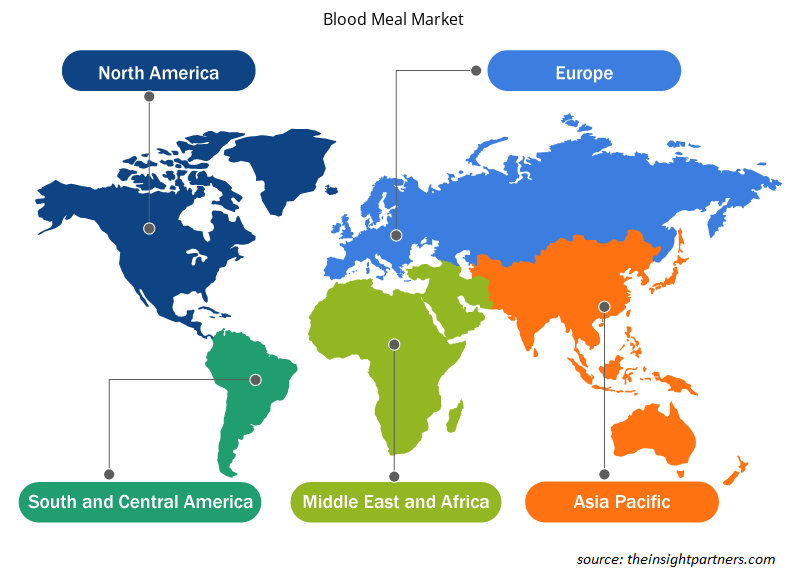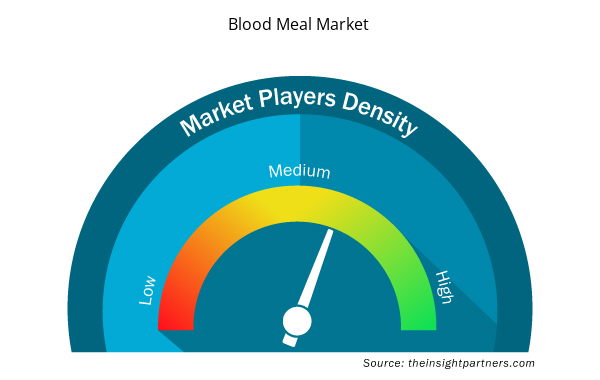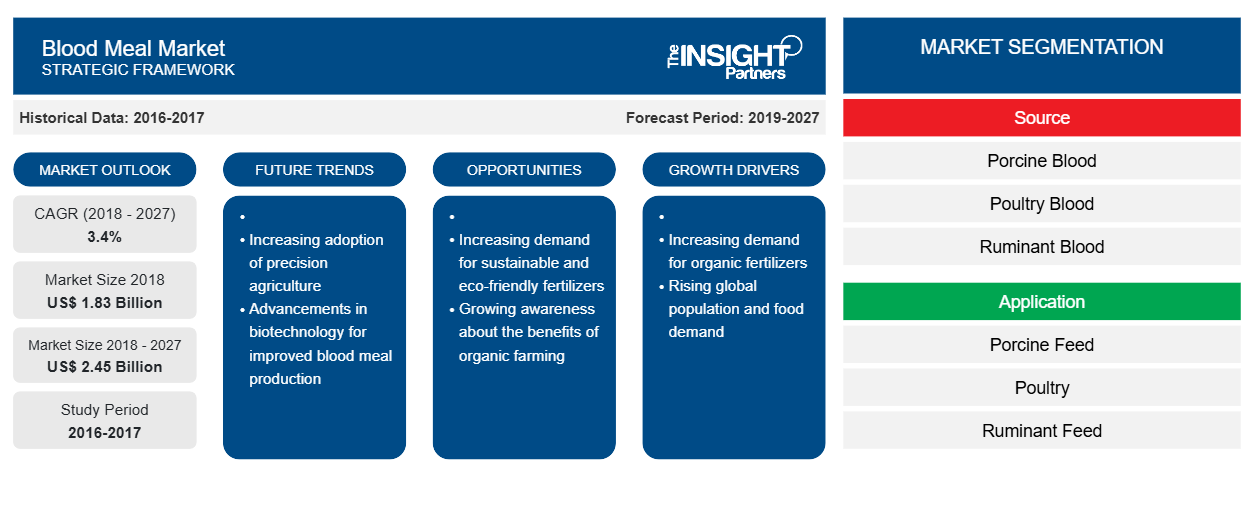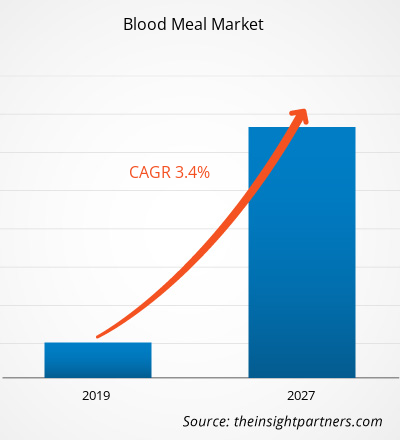Der Markt für Blutmehl hatte im Jahr 2018 einen Wert von 1.825,9 Millionen US-Dollar und soll bis 2027 einen Wert von 2.451,6 Millionen US-Dollar erreichen; für den Zeitraum von 2019 bis 2027 wird ein durchschnittliches jährliches Wachstum von 3,4 % prognostiziert.
Blutmehl ist ein getrocknetes und inertes Pulver, das unter ganz bestimmten Bedingungen aus dem Blut verschiedener Nutztiere, darunter Rinder, Schweine und Hühner, hergestellt wird. Es wird als organischer Dünger mit hohem Stickstoffgehalt und als proteinreiches Futter für Tiere verwendet. Es gilt als eine der reichhaltigsten nicht synthetischen Stickstoffquellen. Blutmehl wird als Nahrungsergänzungsmittel für Nutztiere verwendet und ist hauptsächlich Bestandteil der Lysinversorgung von Nutztieren. Knochenmehl, Blutmehl und andere tierische Nebenprodukte sind in der zertifizierten ökologischen Produktion zugelassen, hauptsächlich als Bodenverbesserungsmittel. Blutmehl ist ein weiteres Knochenmehl; Blutmehl enthält jedoch mehr Stickstoff, während Knochenmehl Phosphor enthält. Blutmehl wird außerdem als Kompostierungsaktivator verwendet. Blutmehl kann auch in Gärten ausgestreut werden, um Schädlinge wie Kaninchen fernzuhalten.
Der Blutmehlmarkt in Nordamerika wird im Prognosezeitraum voraussichtlich mit 4,1 % die höchste durchschnittliche jährliche Wachstumsrate (CAGR) aufweisen. Das Wachstum der Viehwirtschaft spielt eine entscheidende Rolle bei der Deckung des steigenden Nahrungsmittelbedarfs. Blutmehl wird in der Tierfutterindustrie in großem Umfang als Aquafutter , Wiederkäuerfutter und Geflügelfutter eingesetzt. Die Produktion und der Verbrauch von Blutmehl nehmen in den USA aufgrund der steigenden Nachfrage nach gesunden Nahrungsmitteln und der zunehmenden Bedeutung von Bioprodukten in der Bevölkerung weiter zu. Der Anstieg des verfügbaren Pro- Kopf- Einkommens der Verbraucher hat sie zusätzlich dazu motiviert, sich auf gesunde Futterzutaten zu freuen, die das Marktwachstum vermutlich ankurbeln. Die meisten Hersteller nutzen auch die Vorteile der Verwendung kostengünstigerer Zutaten wie Blutmehl in Tierfutter.
Passen Sie diesen Bericht Ihren Anforderungen an
Sie erhalten kostenlos individuelle Anpassungen an jedem Bericht, einschließlich Teilen dieses Berichts oder einer Analyse auf Länderebene, eines Excel-Datenpakets sowie tolle Angebote und Rabatte für Start-ups und Universitäten.
- Holen Sie sich die wichtigsten Markttrends aus diesem Bericht.Dieses KOSTENLOSE Beispiel umfasst eine Datenanalyse von Markttrends bis hin zu Schätzungen und Prognosen.
Auswirkungen von COVID-19 auf den Blutmehlmarkt
Der jüngste COVID-19-Ausbruch begann im Dezember 2019 in Wuhan (China) und hat sich seitdem rasant in allen Regionen der Welt ausgebreitet. Im Mai 2020 waren die USA, Indien, Brasilien, Russland, Spanien, das Vereinigte Königreich und einige andere Länder hinsichtlich bestätigter Fälle und gemeldeter Todesfälle unter den am schlimmsten betroffenen Ländern. Der Ausbruch hat die Volkswirtschaften zahlreicher Länder in Mitleidenschaft gezogen, da als Schutzmaßnahmen gegen die Ausbreitung von COVID-19 Ausgangssperren , Reiseverbote und Geschäftsschließungen verhängt wurden. Die Lebensmittelindustrie gilt als eine der weltweit wichtigsten Branchen, die infolge dieses Ausbruchs unter schweren Fabrikschließungen, Lieferkettenunterbrechungen, Absagen von Technologieveranstaltungen und Büroschließungen leidet. Auch wenn einige Hersteller versuchen, ihre Verluste durch die Umsetzung neuer Strategien auszugleichen, wird es reichlich Zeit brauchen, die durch die Pandemie verursachten Verluste zu überwinden.
Markteinblicke
Steigende Nachfrage nach nahrhaftem Futter
Blut wird aufgrund seines hohen Proteingehalts als flüssiges Protein verwendet und ist reich an Aminosäuren wie Lysin. Es hat einen Vorteil gegenüber pflanzlichem Protein, das einen niedrigen Lysingehalt aufweist. Zu den Faktoren, die das Wachstum des Blutmehlmarktes beeinflussen, gehören der Anstieg des verfügbaren Pro-Kopf-Einkommens der Menschen, ein hoher Lebensstandard, eine wachsende Nachfrage nach tierischen Proteinen und die Tendenz, Bioprodukte zu bevorzugen. Darüber hinaus schafft das Wachstum in der Aquakultur auch die Nachfrage nach nahrhaftem Futter. Es gibt auch eine steigende Nachfrage nach Fleischprodukten und eine Zunahme der Schlachtung von Tieren, was den Produzenten von Blutmehl weitere Möglichkeiten eröffnet. Der anhaltende „Bio-Trend“ erwies sich ebenfalls als positiver Faktor für diesen Markt. Landwirte verwenden Blutmehl als natürlichen Dünger, da es Stickstoff enthält. Die zahlreichen Vorteile von Blutmehl werden voraussichtlich das Marktwachstum im gesamten Prognosezeitraum ankurbeln.
Quellenbasierte Erkenntnisse
Der Blutmehlmarkt ist je nach Quelle in Schweineblut, Geflügelblut und Wiederkäuerblut unterteilt. Das Geflügelblutsegment hatte 2018 den größten Marktanteil, und der Markt für das Schweineblutsegment wird im Prognosezeitraum voraussichtlich mit der höchsten durchschnittlichen jährlichen Wachstumsrate wachsen. Geflügelblut ist der allgemein bevorzugte Rohstoff, der aufgrund seines hohen Aminosäuregehalts, insbesondere Lysin, zur Herstellung von Blutmehl verwendet wird. Geflügelblutmehl ist eine natürliche Proteinquelle, die als Zutat in Tierfutter verwendet wird, hauptsächlich für Schweine, Geflügel, Fische und andere Arten, die keine Wiederkäuer sind. Der Rohstoff wird grundsätzlich aus Schlachthöfen bezogen und in einer Geflügelverarbeitungsanlage verarbeitet. Das Blutmehl ist frei von Zusatzstoffen, die das natürliche Protein verbessern.
Anwendungsbasierte Erkenntnisse
Der Blutmehlmarkt ist je nach Anwendung in Schweinefutter, Geflügelfutter, Wiederkäuerfutter, Aquakulturfutter und andere unterteilt. Das Segment Schweinefutter hatte 2018 den größten Marktanteil, während das Segment Aquakulturfutter im Prognosezeitraum voraussichtlich die höchste durchschnittliche jährliche Wachstumsrate verzeichnen wird. Sprühgetrocknetes Schweineplasma wird durch Verfahren wie das Sammeln des Bluts von geschlachteten Schweinen und das Hinzufügen eines Antikoagulans, im Allgemeinen Natriumcitrat, hergestellt. Anschließend wird es zentrifugiert, um Erythrozyten zu entfernen. Das gesammelte Plasma wird anschließend sprühgetrocknet und zur Herstellung von Tierfutter verwendet.
Prozessbasierte Erkenntnisse
Der Markt für Blutmehl ist verfahrensmäßig in Solartrocknung, Trommeltrocknung, Ring- und Schnelltrocknung sowie Sprühtrocknung unterteilt. Das Segment Ring- und Schnelltrocknung hatte 2018 den größten Marktanteil, während das Segment Solartrocknung im Prognosezeitraum die höchste CAGR verzeichnen dürfte. Das Blut wird zunächst in einen Hochgeschwindigkeits-Venturi-Abschnitt des Systems geleitet. Das Blut gelangt zunächst in den heißen Trocknungsluftstrom, dann verdampft es. Sobald es durch die Trocknungssäule nach oben befördert wird, wird das Produkt weiter getrocknet. Das Vorhandensein eines internen Klassifizierers im Ringtrocknungssystem unterscheidet es hauptsächlich vom Schnelltrockner. Bei der Ringtrocknung wird das Blut durch Dampferhitzung koaguliert; das Koagulum wird zentrifugiert und mit heißem Gas in einem Ringtrockner getrocknet. Das ringgetrocknete Blutmehl bietet einen höheren Gesamtvolumengehalt und ist aufgrund der enthaltenen Aminosäuren von besserer Nährstoffqualität. Beispielsweise beträgt die Lysinverfügbarkeit bei ringgetrocknetem Blutmehl 84 bis 89 Prozent, während sie bei batchgetrocknetem Blutmehl nur bei 62 bis 77 Prozent Lysin liegt.
Fusionen und Übernahmen sowie Forschung und Entwicklung sind die von Unternehmen am häufigsten eingesetzten Strategien, um ihre Präsenz weltweit auszuweiten, was sich weiter auf die Größe des Marktes auswirkt. Die auf dem Blutmehlmarkt vertretenen Akteure wie Ridley Corporation Limited haben die oben genannten Strategien umgesetzt, um ihren Kundenstamm zu erweitern und einen bedeutenden Anteil am Weltmarkt zu gewinnen, was es ihnen auch ermöglicht, ihren Markennamen weltweit aufrechtzuerhalten.
Regionale Einblicke in den Blutmehlmarkt
Die regionalen Trends und Faktoren, die den Blutmehlmarkt während des Prognosezeitraums beeinflussen, wurden von den Analysten von Insight Partners ausführlich erläutert. In diesem Abschnitt werden auch die Blutmehlmarktsegmente und die Geografie in Nordamerika, Europa, im asiatisch-pazifischen Raum, im Nahen Osten und Afrika sowie in Süd- und Mittelamerika erörtert.

- Erhalten Sie regionale Daten zum Blutmehlmarkt
Umfang des Marktberichts zu Blutmehl
| Berichtsattribut | Details |
|---|---|
| Marktgröße im Jahr 2018 | 1,83 Milliarden US-Dollar |
| Marktgröße bis 2027 | 2,45 Milliarden US-Dollar |
| Globale CAGR (2018 - 2027) | 3,4 % |
| Historische Daten | 2016-2017 |
| Prognosezeitraum | 2019–2027 |
| Abgedeckte Segmente | Nach Quelle
|
| Abgedeckte Regionen und Länder | Nordamerika
|
| Marktführer und wichtige Unternehmensprofile |
|
Dichte der Akteure auf dem Blutmehlmarkt: Die Auswirkungen auf die Geschäftsdynamik verstehen
Der Markt für Blutmehl wächst rasant, angetrieben durch die steigende Nachfrage der Endverbraucher aufgrund von Faktoren wie sich entwickelnden Verbraucherpräferenzen, technologischen Fortschritten und einem größeren Bewusstsein für die Vorteile des Produkts. Mit steigender Nachfrage erweitern Unternehmen ihr Angebot, entwickeln Innovationen, um die Bedürfnisse der Verbraucher zu erfüllen, und nutzen neue Trends, was das Marktwachstum weiter ankurbelt.
Die Marktteilnehmerdichte bezieht sich auf die Verteilung der Firmen oder Unternehmen, die in einem bestimmten Markt oder einer bestimmten Branche tätig sind. Sie gibt an, wie viele Wettbewerber (Marktteilnehmer) in einem bestimmten Marktraum im Verhältnis zu seiner Größe oder seinem gesamten Marktwert präsent sind.
Die wichtigsten auf dem Blutmehlmarkt tätigen Unternehmen sind:
- Allanasonsn Pvt Ltd
- APC Company, Inc.
- Apelsa Guadalajara, SA de CV
- DAR PRO – Inhaltsstoffe
- Ridley Corporation Limited
Haftungsausschluss : Die oben aufgeführten Unternehmen sind nicht in einer bestimmten Reihenfolge aufgeführt.

- Überblick über die wichtigsten Akteure auf dem Blutmehlmarkt
Bericht-Spotlights
- Fortschrittliche Branchentrends auf dem globalen Blutmehlmarkt helfen den Akteuren bei der Entwicklung wirksamer langfristiger Strategien
- Von Unternehmen in Industrie- und Entwicklungsmärkten verfolgte Wachstumsstrategien
- Quantitative Analyse des globalen Blutmehlmarktes von 2017 bis 2027
- Schätzung des weltweiten Blutmehlbedarfs verschiedener Branchen
- PEST-Analyse zur Veranschaulichung der Wirksamkeit von Käufern und Lieferanten, die im Blutmahlzeit-Ökosystem tätig sind
- Aktuelle Entwicklungen zum Verständnis des Wettbewerbsmarktszenarios und der globalen Nachfrage nach Blutmehl
- Markttrends und -aussichten sowie Faktoren, die das Wachstum des globalen Blutmehlmarktes vorantreiben und bremsen
- Erkenntnisse, die den Entscheidungsprozess unterstützen, indem sie Strategien verstehen, die das kommerzielle Interesse im Hinblick auf das Wachstum des Blutmehlmarktes weltweit untermauern
- Globale Blutmehlmarktgröße an verschiedenen Knotenpunkten des Marktes
- Detaillierte Übersicht und Segmentierung des globalen Blutmehlmarktes sowie der Dynamik der Blutmehlindustrie
- Globale Blutmehlmarktgröße in verschiedenen Regionen mit vielversprechenden Wachstumschancen
Blutmehlmarkt – nach Quelle
- Schweineblut
- Geflügelblut
- Wiederkäuerblut
Blutmehlmarkt – nach Anwendung
- Schweinefutter
- Geflügelfutter
- Wiederkäuerfutter
- Aqua Feed
- Sonstiges
Blutmehlmarkt – nach Verfahren
- Solare Trocknung
- Trommeltrocknung
- Ring- und Schnelltrocknung
- Sprühtrocknung
Firmenprofile
- Allanasons Pvt Ltd
- APC Company, Inc.,
- Apelsa Guadalajara, SA de CV
- DAR PRO – Inhaltsstoffe
- Ridley Corporation Limited
- Sanimax
- TerramarChile
- Die Boyer Valley Company, Inc.
- Valley Proteins, Inc.
- FASA-Gruppe
- Historische Analyse (2 Jahre), Basisjahr, Prognose (7 Jahre) mit CAGR
- PEST- und SWOT-Analyse
- Marktgröße Wert/Volumen – Global, Regional, Land
- Branche und Wettbewerbsumfeld
- Excel-Datensatz



Report Coverage
Revenue forecast, Company Analysis, Industry landscape, Growth factors, and Trends

Segment Covered
This text is related
to segments covered.

Regional Scope
North America, Europe, Asia Pacific, Middle East & Africa, South & Central America

Country Scope
This text is related
to country scope.
Häufig gestellte Fragen
Ans.Among all three segments of source, the poultry blood segment has led the market in 2018 and is expected to be the dominant segment in the near future.Poultry blood is collected from chicken mainly for two purposes, such as to obtain serum, which can be tested for various disease virus antibodies, no anticoagulant is required in this process, and the blood is allowed to clot. The levels of antibody detected in individual birds and flocks give an indication of the response to vaccination. It also indicates whether birds have been challenged by field strains of any disease virus. Secondly, to obtain red blood cells, the blood is collected into anticoagulant. These can be further used in preparing blood meal. A blood meal is produced from poultry by-products as a high-protein component in animal feeds. The minimum protein content found in poultry blood meal is 80%. A poultry Blood meal is one of the natural sources of protein, which is used as an ingredient animal feed for swine, poultry, fish, and other non-ruminant species. Poultry blood is on-demand from the pet food manufacturing industry due to an increase in demand for more pet food.
The major players operating in the global blood meal market are Allanasons Pvt Ltd, APC Company, Inc., Apelsa Guadalajara, SA de CV, DAR PRO Ingredients, Ridley Corporation Limited, Sanimax, Terramar Chile, The Boyer Valley Company, Inc., Valley Proteins, Inc., FASA Group, and among many others.
In 2018, the blood mealmarket was predominantbyAsia-Pacific at theglobal level.Asia-pacific is the largest continent in the world and is known for its organic agriculture and feed products. Asia has ranked highest amongst feed producing regions. China is dominating the regional market, followed by other countries such as Japan, India, Vietnam, Korea, Thailand, Malaysia, and Indonesia. These countries are witnessing rising demand for poultry, egg, and meat products. Apart from its utility in the feed industry, blood meal is extensively utilized as an organic fertilizer to promote the growth of crops and to control pests. The growing consciousness among consumers for a healthy lifestyle has posed a demand for healthy animal-derived products, which is expected to boost the demand for blood meal in global market.
Trends and growth analysis reports related to Food and Beverages : READ MORE..
The List of Companies - Blood Meal Market
- Allanasonsn Pvt Ltd
- APC Company, Inc.
- Apelsa Guadalajara, SA de CV
- DAR PRO Ingredients
- Ridley Corporation Limited
- Sanimax
- Terramar Chile SpA
- The Boyer Valley Company, Inc
- Valley Proteins, Inc.
- FASA Group
The Insight Partners performs research in 4 major stages: Data Collection & Secondary Research, Primary Research, Data Analysis and Data Triangulation & Final Review.
- Data Collection and Secondary Research:
As a market research and consulting firm operating from a decade, we have published and advised several client across the globe. First step for any study will start with an assessment of currently available data and insights from existing reports. Further, historical and current market information is collected from Investor Presentations, Annual Reports, SEC Filings, etc., and other information related to company’s performance and market positioning are gathered from Paid Databases (Factiva, Hoovers, and Reuters) and various other publications available in public domain.
Several associations trade associates, technical forums, institutes, societies and organization are accessed to gain technical as well as market related insights through their publications such as research papers, blogs and press releases related to the studies are referred to get cues about the market. Further, white papers, journals, magazines, and other news articles published in last 3 years are scrutinized and analyzed to understand the current market trends.
- Primary Research:
The primarily interview analysis comprise of data obtained from industry participants interview and answers to survey questions gathered by in-house primary team.
For primary research, interviews are conducted with industry experts/CEOs/Marketing Managers/VPs/Subject Matter Experts from both demand and supply side to get a 360-degree view of the market. The primary team conducts several interviews based on the complexity of the markets to understand the various market trends and dynamics which makes research more credible and precise.
A typical research interview fulfils the following functions:
- Provides first-hand information on the market size, market trends, growth trends, competitive landscape, and outlook
- Validates and strengthens in-house secondary research findings
- Develops the analysis team’s expertise and market understanding
Primary research involves email interactions and telephone interviews for each market, category, segment, and sub-segment across geographies. The participants who typically take part in such a process include, but are not limited to:
- Industry participants: VPs, business development managers, market intelligence managers and national sales managers
- Outside experts: Valuation experts, research analysts and key opinion leaders specializing in the electronics and semiconductor industry.
Below is the breakup of our primary respondents by company, designation, and region:

Once we receive the confirmation from primary research sources or primary respondents, we finalize the base year market estimation and forecast the data as per the macroeconomic and microeconomic factors assessed during data collection.
- Data Analysis:
Once data is validated through both secondary as well as primary respondents, we finalize the market estimations by hypothesis formulation and factor analysis at regional and country level.
- Macro-Economic Factor Analysis:
We analyse macroeconomic indicators such the gross domestic product (GDP), increase in the demand for goods and services across industries, technological advancement, regional economic growth, governmental policies, the influence of COVID-19, PEST analysis, and other aspects. This analysis aids in setting benchmarks for various nations/regions and approximating market splits. Additionally, the general trend of the aforementioned components aid in determining the market's development possibilities.
- Country Level Data:
Various factors that are especially aligned to the country are taken into account to determine the market size for a certain area and country, including the presence of vendors, such as headquarters and offices, the country's GDP, demand patterns, and industry growth. To comprehend the market dynamics for the nation, a number of growth variables, inhibitors, application areas, and current market trends are researched. The aforementioned elements aid in determining the country's overall market's growth potential.
- Company Profile:
The “Table of Contents” is formulated by listing and analyzing more than 25 - 30 companies operating in the market ecosystem across geographies. However, we profile only 10 companies as a standard practice in our syndicate reports. These 10 companies comprise leading, emerging, and regional players. Nonetheless, our analysis is not restricted to the 10 listed companies, we also analyze other companies present in the market to develop a holistic view and understand the prevailing trends. The “Company Profiles” section in the report covers key facts, business description, products & services, financial information, SWOT analysis, and key developments. The financial information presented is extracted from the annual reports and official documents of the publicly listed companies. Upon collecting the information for the sections of respective companies, we verify them via various primary sources and then compile the data in respective company profiles. The company level information helps us in deriving the base number as well as in forecasting the market size.
- Developing Base Number:
Aggregation of sales statistics (2020-2022) and macro-economic factor, and other secondary and primary research insights are utilized to arrive at base number and related market shares for 2022. The data gaps are identified in this step and relevant market data is analyzed, collected from paid primary interviews or databases. On finalizing the base year market size, forecasts are developed on the basis of macro-economic, industry and market growth factors and company level analysis.
- Data Triangulation and Final Review:
The market findings and base year market size calculations are validated from supply as well as demand side. Demand side validations are based on macro-economic factor analysis and benchmarks for respective regions and countries. In case of supply side validations, revenues of major companies are estimated (in case not available) based on industry benchmark, approximate number of employees, product portfolio, and primary interviews revenues are gathered. Further revenue from target product/service segment is assessed to avoid overshooting of market statistics. In case of heavy deviations between supply and demand side values, all thes steps are repeated to achieve synchronization.
We follow an iterative model, wherein we share our research findings with Subject Matter Experts (SME’s) and Key Opinion Leaders (KOLs) until consensus view of the market is not formulated – this model negates any drastic deviation in the opinions of experts. Only validated and universally acceptable research findings are quoted in our reports.
We have important check points that we use to validate our research findings – which we call – data triangulation, where we validate the information, we generate from secondary sources with primary interviews and then we re-validate with our internal data bases and Subject matter experts. This comprehensive model enables us to deliver high quality, reliable data in shortest possible time.


 Holen Sie sich ein kostenloses Muster für diesen Bericht
Holen Sie sich ein kostenloses Muster für diesen Bericht